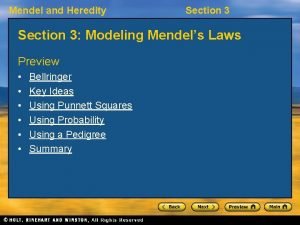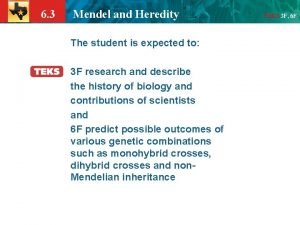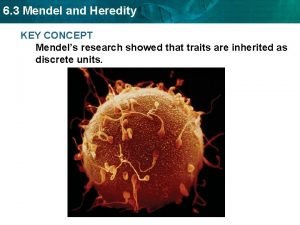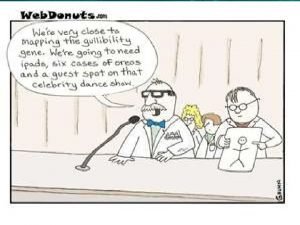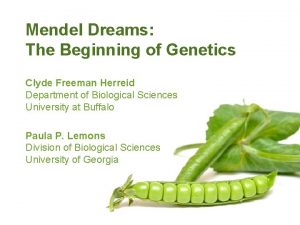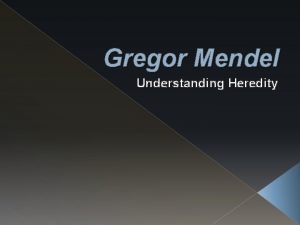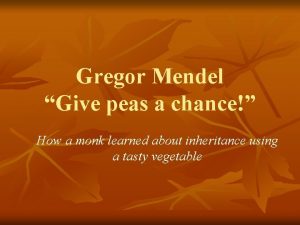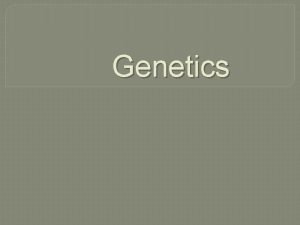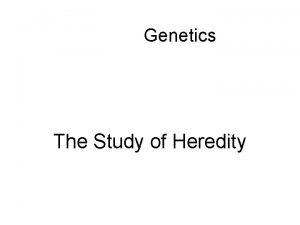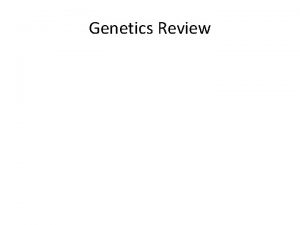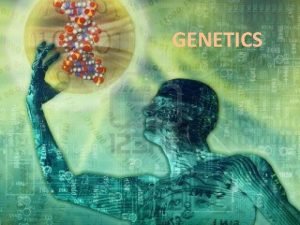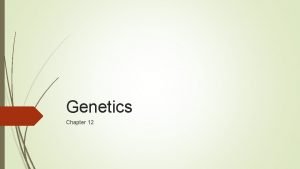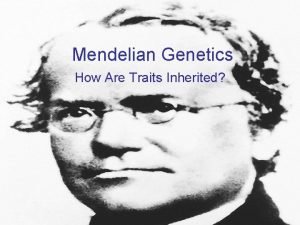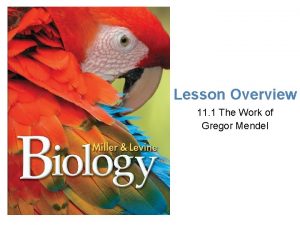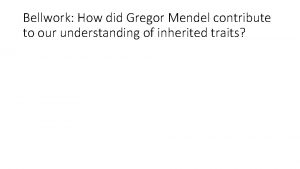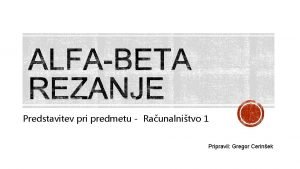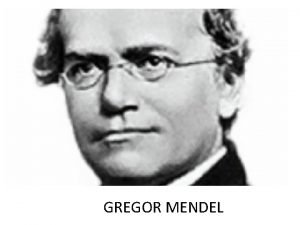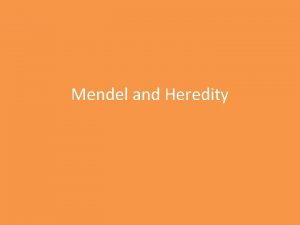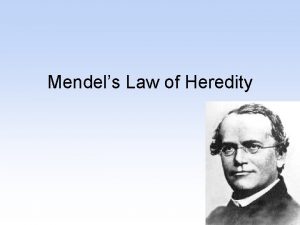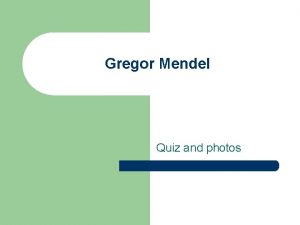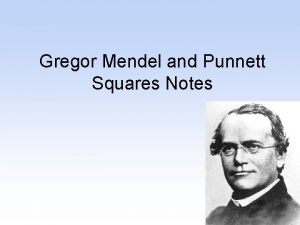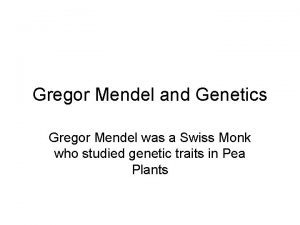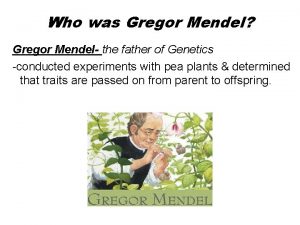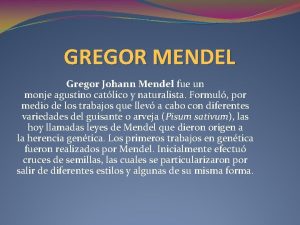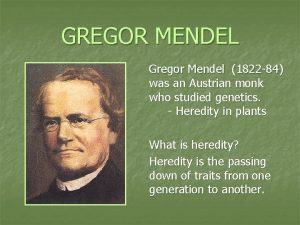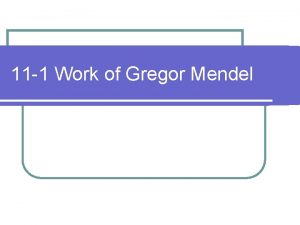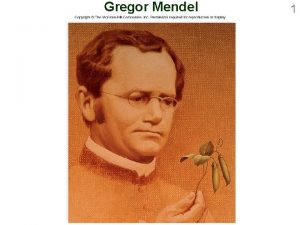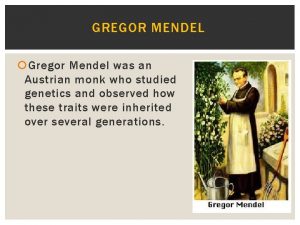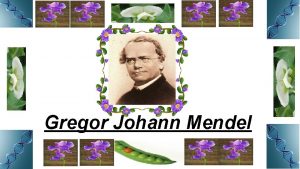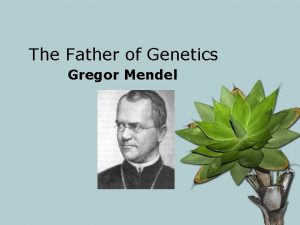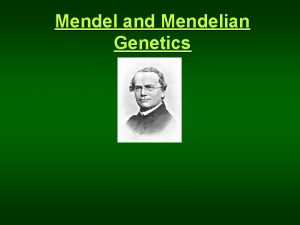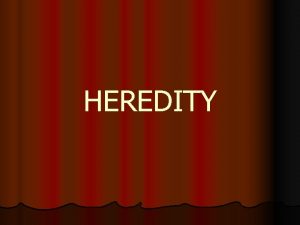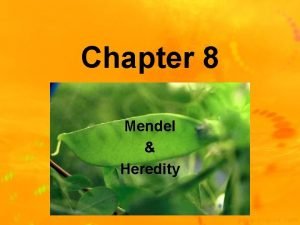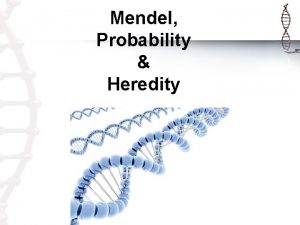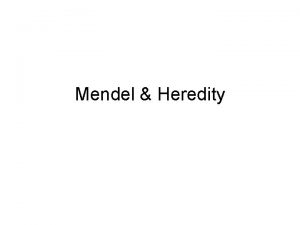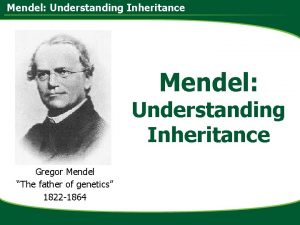Mendel and Heredity Mendel and Heredity Terms Gregor




























- Slides: 28

Mendel and Heredity

Mendel and Heredity Terms • Gregor Mendel- “Father of Genetics” • Traits- characteristics that are inherited – Ex. Eye color, hair color • Genetics- study of biological inheritance patterns • Purebred- offspring inherit all of parents characteristics, genetically uniform

Mendel and Heredity Terms • Cross- mating of two organisms • Gene- piece of DNA that provides a set of instruction to a cell • Allele- any alternative form of a gene that may occur

Mendel and Heredity Terms • Homozygous- two of the same alleles • Heterozygous- two different alleles

Mendel and Heredity Terms • Genotype- genetic makeup of a specific set of genes • Phenotype- physical characteristics or appearance of an organism • Dominant- allele is expressed when two different alleles are present • Recessive- allele is expressed only when two copies are present

Genetics • In the 1800’s, Gregor Mendel laid the groundwork for modern genetics • He crossed many pea plants and observed traits of offspring • Discovered that – Organisms inherit two copies of each gene, one from each parent

Genetics • Peas either: – Round (dominant) – Wrinkled (recessive) • Genotypes – RR (homozygous dominant) – Rr (heterozygous) – rr (homozygous recessive) Phenotypes -round -wrinkled

Genetics • Another example: • Brown (dominant) vs. black (recessive) • Genotypes? Phenotypes?

Genetics • Mendel’s discoveries led to the Punnett square • Developed by R. C. Punnett • Used to predict genotypes of offspring • Example: – Straight (dom. ) vs. curly (rec. ) – Dad-heterozygous – Mom-homozygous recessive

Dihybrid Punnett Square • Predicting more than one trait • EX. Cross a tall pea plant with green leaves with a short pea plant with yellow leaves. 1. 2. 3. 4. Determine parent genotypes. Find combinations of alleles. Fill out Punnett square. Determine phenotypes of offspring.

Dihybrid Punnett Square • EX. Cross a tall (homozygous) pea plant with green (heterozygous) leaves with a short pea plant with yellow leaves. (Tall is dominant to short, green is dominant to yellow)

Dihybrid Practice • Cross the parents Ss. Yy x Ss. Yy SY Sy s. Y sy SY SSYY Sy SSYy Ss. YY Ss. Yy Ssyy Ss. YY Ss. Yy ss. YY ss. Yy sy Ss. Yy Ssyy ss. Yy ssyy s. Y Smooth/Yellow __9____ Smooth/Green ___3___ Rough/Yellow ____3__ Rough/Green _____1_

Bellringer: Complete both questions in your notebook • 1. In one particular species of cats, long hair is dominant to short hair. If a heterozygous male is crossed with a homozygous recessive female, what is the probability that one of the offspring has long hair? • 2. A homozygous dominant flower is crossed with a homozygous recessive flower. Purple flowers are dominant to red flowers. What are the genotypes and phenotypes of the offspring?

Sex-linked Genes • Sex-linked genes- genes located on the sex chromosomes – Female (XX), Male (XY) X Y X XX XY X

Incomplete Dominance • Alleles that show incomplete dominance show both the dominant and recessive traits • Neither allele is completely dominant or recessive • Ex. If a homozygous red flower and homozygous white flower cross, the offspring have pink flowers

Codominance • Both the dominant and recessive alleles are expressed • Ex. Red and white flower are crossed, the offspring will be red and white

Exit Slip 1. Sex linked genes are located _______. 2. A dog that shows the phenotypes of both his mother and father would be an example of (incomplete or codominance). 3. A blue flower crosses with a yellow flower to produce a green flower. This is an example of (incomplete or codominance).

Pedigree • Pedigree- chart that can help trace phenotypes and genotypes in a family – Helps to determine if people carry the recessive allele

Pedigree

Pedigree • Reading a pedigree

Example ○ □ □ ○ How many boy children? How many girl children? Is the oldest child a boy or girl? □

Griffith Experiment

DNA Structure • DNA is a polymer made of monomers called nucleotides • Each nucleotide is made of: – A phosphate group – Deoxyribose (sugar) – Nitrogen containing base

Types of Nucleotides • C – Cytosine Pyrimidines • T – Thymine • A – Adenine Purines • G – Guanine

Base-Pairing Rules • Nucleotides always pair in the same way – Thymine (T) always pairs with Adenine (A) – Cytosine (C) always pairs with Guanine (G) – Ex. TTACGTAG AATGCATC

DNA Structure • DNA is in the shape of a double helix • Each nucleotide is paired

Exit Slip 1. Thymine is an example of a _______. • nucleotide 2. The shape of DNA is known as a ______. • Double helix 3. Write the DNA base pair: TCGGAATCCACGTG ________ – AGCCTTAGGTGCAC

DNA Replication • Replication is a process by which DNA is copied • Occurs during the S stage of the cell cycle
 Who is gregor mendel and what is he famous for
Who is gregor mendel and what is he famous for Who is gregor mendel and what did he do?
Who is gregor mendel and what did he do? Section 3 mendel and heredity
Section 3 mendel and heredity Section 3 mendel and heredity
Section 3 mendel and heredity Mendel 9 3 3 1
Mendel 9 3 3 1 Section 3 mendel and heredity
Section 3 mendel and heredity Section 3 mendel and heredity
Section 3 mendel and heredity Section 11-1 the work of gregor mendel
Section 11-1 the work of gregor mendel Austrian genetic traits
Austrian genetic traits Father of genetics
Father of genetics Gregor mendel's dream was to?
Gregor mendel's dream was to? Gregor mendel chart
Gregor mendel chart Chapter 12 lesson 1 the work of gregor mendel
Chapter 12 lesson 1 the work of gregor mendel Suit separate
Suit separate What did gregor mendel research
What did gregor mendel research Who is gregor mendel
Who is gregor mendel How many pairs of chromosomes
How many pairs of chromosomes Gregor mendel conclusion
Gregor mendel conclusion The work of gregor mendel lesson 1 chapter 12
The work of gregor mendel lesson 1 chapter 12 Chapter 11 biology test
Chapter 11 biology test Gregor mendel punnett square
Gregor mendel punnett square Gregor mendel plant
Gregor mendel plant Gregor mendel
Gregor mendel Gregor mendel summary
Gregor mendel summary Gregor johann mendel steckbrief
Gregor johann mendel steckbrief Mendel's law of independent assortment and segregation
Mendel's law of independent assortment and segregation How did gregor mendel contribute to genetics
How did gregor mendel contribute to genetics Gregor mendel referat
Gregor mendel referat Gregor mendel
Gregor mendel


